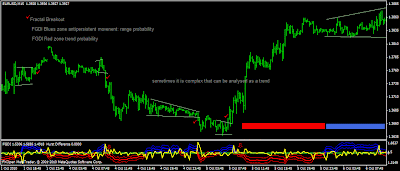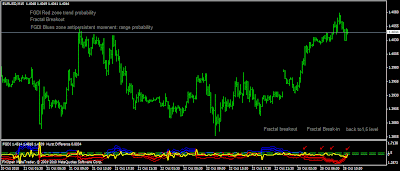

The first system I will develop on this blog is the break - out trading system.In fact this intra-day strategy is well known and is used every day by the professional traders. It is the the same system or almost, because we are going to introduce some new techniques.
Why by the professional traders?
The explanation is simple, in fact to use this strategy you have to be at the computer terminal and to wait for the proper conditions to happen. Everything is played in seconds and if you miss your entry you miss your day.
The second reason is that break - outs often occur in the beginning of the European session and at the opening of the US session. Well during those times it is the day work of the professional traders. They are there and they are watching for their daily opportunities. During this time the casual and amateur traders are at their work, in their office or simply doing their business. When they get back home and start the terminal they just observe tons of missed opportunities and that is normal. After that they try to play a break - out strategy when it is most unlikely to happen (mostly during hours of diminishing volatility) and as a consequence the odds are against them and they fail.
The third reason is that in order to use a break - out trading system you need to have an appropriate broker. If you use a normal retail broker despite of their advertisement of fixed spread you will be re-quoted or slipped. You need to have a special broker services to succeed with this strategy. For example an excellent choice is Dukaskopy, but in order to open account with them you need a large account that is beyond the possibilities of the average retail wannabe speculator. And as this blog is specially dedicated to the average wannabe retail Forex speculator it is important to note that. You will be the last guy to react. The first reason is that you are not properly trained and a professional guy will be much quicker in their response, and the second reason is that you will get a worse fill than the professional guy.
OK the good news is that as the Forex market works 24 hours a day you may be in a position to be able to use a time window appropriate for a break - out system. You have to be very motivated to do that because if you are US citizen you will have to wake up in the night to watch for break - out opportunities during the open of the European session.
Classical description of the strategy
The simplest form is a channel break - out.
Channel breakouts occur on the upside and downside.
Upwards channel break: when the price of a currency rises above the top channel line.
Down side channel break: when the price of currency falls below the bottom channel line
Just google the term price channel and you will get a plethora of technical sites explaining it and how it is traded.
Basically the ideal price movement is in a price channel. The price channel can be horizontal (range channel) or directional (trend channel). In fact it does not matter the type. When a price breaks the borders of a chart channel we have a break - out of the channel. If that happens we have a probability that the market conditions has changed and the price will further go away from the channel.
The channel can be regular but it can be irregular. All the classifications of the channels is in fact the technical analysis.
So it may appear a paradox but the technical analyse is just a classification of the extern characteristics of trading ranges without any kind of insight what is going on.
In fact a break - out of a trading range is the Bread and Butter of the technical analysis.
The form of all the technical chart patterns is a result of random events (some guys think that they are a result of Chaotic Attractors and are chaotic events). What is the truth I do not know my opinion is that they are mostly chaotic but sometimes the chaos is so great that in practice we can analyse them as random.
We can have a channel, we can have a triangle, we can have a wedge. What we have is a product of the market activity.
All the classification of the technical analysis is somewhat artificial. That is because it classifies the external traits and not the true internal characteristics that are hidden.
But do not be mis-leaded, the classification is useful, because when a pattern is identified is defines the game of play of the market participants.
Well let do some basic staff.
A channel defines a trading range. We have up limits and down limits of the channel. You need at least two points from above and from below to draw a price channel. Then just draw a line connecting the up limits and the down limits of the channel.
Well, but when the prices goes beyond the channel and the gets back to the channel often the technical guys will tell you that you have drawn the channels improperly and you need more educations. When you get more education you will draw the lines properly but again you will see the prices go beyond the channel and get back to the channel. As in the avatar the pilot says before going to battle Ain't that a shit.
This is called a false break - out that happens more often that we want to admit (50 % of the cases ;) ). Ain't that a shit again?
Anyway My idea is to get new details how to trade a Break - out.
1. Use of the volatility probability
We have a break - out probability in periods of increased volatility. So it is necessary to check statistically the volatility. This is well known by the professional players.
2. Use of fractal indicators FGDI, IVAR, FDI
We use a fractal dimension graph index indicator (FGDI). When a breakout occurs it is accompanied with a change of the fractal state of the price series.
2.1 Fractal Break - out
Conditions: We are at a blue zone with fractal dimension greater than 1.5. We move to a zone below 1.5. This is a fractal breakout
This is usually observed after a range (FGDI greater than 1,5)
2.2 Fractal Break - in
We are at a red xone, fractal dimension less than 1,5. The fractal dimension get lower.
This is usually observed in an established trend when we have a breakout in the direction of the trend
3. A peak in the Hurst Difference
Well this is a kind of measure of the change of the transition of the fractal dimension from one state to the other.
4. Use the correlation between the Forex pairs
Use an indicator to compare the correlations in real time. Do not rely only on historical correlations. This method requires much more experience.
For exemple:
EUR/USD and GBP/USD are positively correlated: when the euro goes up the pound does the same
EUR/USD anf USD/CHF are negatively correlated: when the euro goes up the frank goes down
For example in a case of a break out it is highly unlikely that the pairs are going to have a break out in a different direction.
For example you see a valid break-out in the euro with change of fractal dimension and a peak in the Hurst difference. It is highly unlikely that the pound will do a break out in the same time. There is a usually a delay. So use this to have a fill at advantage conditions in fact we still can have a good fill in the euro but sometimes in highly volatility conditions the fill will be very bad with a lot of slippage (experienced traders prefer to enter after a correction and this is especially true when you have a long break - out bar). In this case a fill in the pound or/and the frank can be a good idea, of course the spread is larger but the fill will be in normal conditions.
Do not try this during news releases. I haven't tested yet and can make any recommendation whatsoever.
EXAMPLES
OK let's now look at some recent chart. You will see how this can enhance the technical analysis and especially to confirm a technical breakout. Look at the screen shots at the beginning of the post.
You will see the conjunction between a technical analysis breakout and a fractal breakout.
This can help you to identify when a break out is a real one.
Look at the charts the trend channels are drown differently the fractal dimension analysis helps us to have a more clear picture of what is the real price state. Fore example during the Asian session you can see a clear trend. But this was not what happened. We had a treading range and a little break out. When you see the sum of it yeah, it appears like a trend but...
FRACTAL TECHNICAL ANALYSIS: New rules for drawing trend lines
According to the fractal technical analysis the rules of drawing trend lines are different.
A trend line is used to draw a channel of price range. It is logically to draw channels only when we have the same characteristics of the price time series.
Draw trend lines only for red zones or blue zones.
Do not Draw trend lines in a zone where you have a combination between a high fractal dimension (blue FGDI, antipersitent movement and range probability) and a low fractal dimension (red FGDI, persistent movement and trend possibility).
After that draw the classic trend lines. In this case we can have a clearer picture of the trend lines.







 03:29
03:29
 fxhackers
fxhackers



